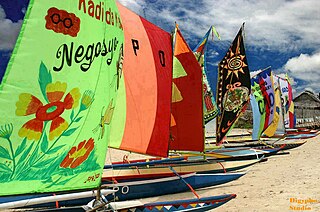Related Research Articles

A magnetic sail is a proposed method of spacecraft propulsion where an onboard magnetic field source interacts with a plasma wind to form an artificial magnetosphere that acts as a sail, transferring force from the wind to the spacecraft requiring little to no propellant as detailed for each proposed magnetic sail design in this article.

A barquentine or schooner barque is a sailing vessel with three or more masts; with a square rigged foremast and fore-and-aft rigged main, mizzen and any other masts.

Sailly-au-Bois is a commune in the Pas-de-Calais department in the Hauts-de-France region of France.

Sailly-en-Ostrevent is a commune in the Pas-de-Calais department in the Hauts-de-France region of France.

Sailly-Labourse is a commune in the Pas-de-Calais department in the Hauts-de-France region of France about 3 miles (4.8 km) southeast of Béthune and 24 miles (39 km) southwest of Lille.

Sailly-sur-la-Lys is a commune in the Pas-de-Calais department in the Hauts-de-France region of France.

Sailly-lez-Lannoy is a commune in the Nord department in northern France. It is part of the Métropole Européenne de Lille.

Sailly is a commune in the Ardennes department in northern France.

Sailly-lez-Cambrai is a commune in the Nord department in northern France.

Sailly-Achâtel is a commune in the Moselle department in Grand Est in north-eastern France.

Sailly is a commune in the Saône-et-Loire department in the region of Bourgogne-Franche-Comté in eastern France.

Sailly-Flibeaucourt is a commune in the Somme department in Hauts-de-France in northern France.

Sailly-Laurette is a commune in the Somme department in Hauts-de-France in northern France.

Sailly-le-Sec is a commune in the Somme department in Hauts-de-France in northern France.

The Javelin is a high-performance skiff type dinghy sailed in Australia and New Zealand. The class was founded by designer John Spencer in 1961. Spencer also founded the Cherub Class. It is 14 feet long, sporting a large sail area, single trapeze and asymmetrical spinnaker. The Javelin is a development class, meaning that boats vary in shape within a framework of rules, rather than being all built to the same design. Bruce Farr is another well-known designer who drew successful Javelins.

The leading edge is the part of the wing that first contacts the air; alternatively it is the foremost edge of an airfoil section. The first is an aerodynamic definition, the second a structural one. As an example of the distinction, during a tailslide, from an aerodynamic point of view, the trailing edge becomes the leading edge and vice versa but from a structural point of view the leading edge remains unchanged.
Amatasi are a type of Samoan double-hulled watercraft. Its sails were woven pandanus leaves tied to 2 spars. The hull was sometimes built of planks. Lashed together, large double canoes 30–60 feet long could carry 25 men on journeys of hundreds of miles.
The Topaz Taz is a sailing dinghy created by Topper International designed for between 1 or 2 children. The Taz is an ISAF ‘Learn to Sail’ class.

Bigiw is a small double-outrigger sailboat native to the islands of Mindanao, Visayas, and Palawan in the Philippines. It is used for personal transport or small-scale fishing and can hold one to three people. It is traditionally propelled by sails and steered with a single oar, but is commonly motorized in modern times. It can also be paddled. The sail type used is predominantly triangular crab claw sails, but it can also use spritsails or tanja sails.
The Compass Careel 18 is an 18 ft long trailer sailer manufactured in Australia by David Rose Yachts.
References
- ↑ C. A. Marchaj (2003) [1996]. Sail Performance. Camden, Maine: International Marine/McGraw Hill. p. 4.